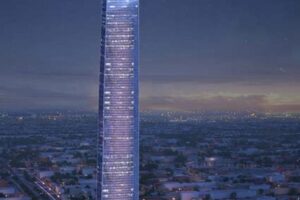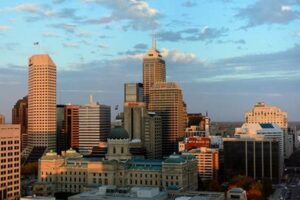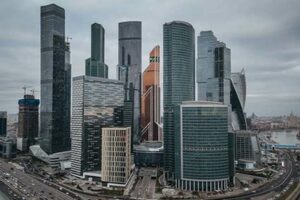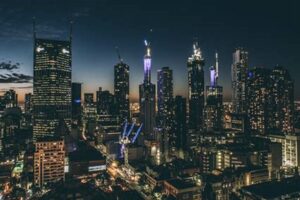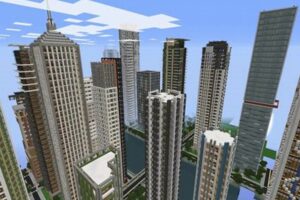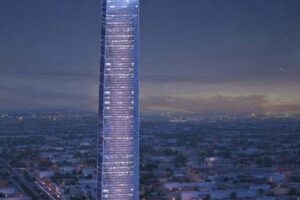A 100-mile long skyscraper city is a hypothetical urban development concept that envisions a continuous linear city stretching over 100 miles. Such a city would be characterized by its extreme length and its vertical rather than horizontal growth, with skyscrapers serving as the primary residential, commercial, and industrial structures.
The concept of a 100-mile long skyscraper city has been explored by architects and urban planners for decades. One of the main advantages of such a city would be its ability to accommodate a large population within a relatively small footprint, making it a more sustainable and efficient use of land. Additionally, a linear city could be designed to be more walkable and bikeable than traditional cities, reducing traffic congestion and pollution.
However, there are also a number of challenges associated with the construction of a 100-mile long skyscraper city. One of the biggest challenges would be the cost of such a project. Additionally, it would be necessary to develop new technologies to construct and maintain such a long and narrow city.
1. Length
The defining characteristic of a “100-mile long skyscraper city” is its extraordinary length, stretching over 100 miles. This unprecedented scale introduces unique challenges and opportunities in various aspects of urban planning and design.
- Uninterrupted Skyline: The sheer length of the city would create an uninterrupted skyline, a striking visual spectacle unlike anything seen before. Imagine a continuous horizon of towering skyscrapers, stretching as far as the eye can see, creating a sense of awe and grandeur.
- Linear Infrastructure: The city’s elongated form would necessitate a carefully planned linear infrastructure system. Transportation networks, utility lines, and communication systems would need to be designed to efficiently serve the entire length of the city, ensuring seamless connectivity and accessibility for residents and businesses.
- Zoning and Land Use: The 100-mile length would require thoughtful zoning and land use planning to create a balanced and functional city. Different areas could be designated for residential, commercial, industrial, and recreational purposes, ensuring a diverse and vibrant urban environment.
- Sustainable Design: The vast scale of the city presents both challenges and opportunities for sustainable design. By incorporating green building practices, renewable energy sources, and efficient transportation systems, the city could minimize its environmental impact and promote a healthier living environment for its inhabitants.
In conclusion, the “Length: 100 miles” aspect of a 100-mile long skyscraper city significantly influences its urban design, infrastructure, land use, and sustainability considerations. Careful planning and innovative solutions will be crucial to harness the potential of such a unique and ambitious urban concept.
2. Height
In a “100-mile long skyscraper city,” the height of the skyscrapers is a defining characteristic that fundamentally shapes the urban environment and the lives of its inhabitants. Skyscrapers serve as the primary building blocks of this extraordinary city, creating a unique vertical landscape that sets it apart from traditional urban developments.
The height of the skyscrapers allows for an extremely high population density, accommodating a large number of residents and businesses within a relatively small footprint. This vertical growth strategy helps preserve valuable land resources and promotes efficient land use. By building upwards instead of outwards, the city can minimize its environmental impact and create a more sustainable urban environment.
Furthermore, skyscrapers offer panoramic views and abundant natural light, enhancing the quality of life for residents. They can also incorporate green spaces, such as rooftop gardens and vertical parks, providing much-needed respite and contributing to the overall well-being of the city’s population.
However, the construction and maintenance of skyscrapers require advanced engineering techniques and specialized materials, making them expensive to build and manage. Additionally, the height of the buildings can pose challenges for emergency services and evacuation procedures in the event of an emergency.
In conclusion, the “Height: Skyscrapers” aspect of a “100-mile long skyscraper city” presents both opportunities and challenges. By embracing innovative design and construction methods, architects and engineers can harness the potential of skyscrapers to create a sustainable, efficient, and visually striking urban environment.
3. Density
In a “100-mile long skyscraper city,” the high population density is a direct consequence of the city’s unique urban design and the predominance of skyscrapers as the primary building type. This high density brings about a range of implications and considerations that shape various aspects of the city’s functioning and livability.
The concentration of a large population within a relatively small area creates a dynamic and vibrant urban environment. It fosters a sense of community and promotes social interaction, cultural exchange, and economic activity. High-density developments often support a mix of residential, commercial, and recreational uses, creating walkable and bikeable neighborhoods where residents can easily access daily necessities and amenities.
However, high population density also presents challenges that need to be carefully addressed. Densely populated areas require efficient and well-planned infrastructure to manage transportation, water supply, sanitation, and waste disposal. Urban planning and design play a crucial role in ensuring that high-density developments are sustainable and provide a high quality of life for residents.
Examples of successful high-density developments can be found in cities around the world, such as Hong Kong, Singapore, and New York City. These cities have demonstrated that it is possible to create livable and sustainable urban environments with high population densities by implementing innovative urban planning strategies, promoting public transportation, and preserving green spaces.
In conclusion, the “Density: High population density” aspect of a “100-mile long skyscraper city” is a key determinant of its urban character and presents both opportunities and challenges. By carefully planning and managing high-density developments, it is possible to harness the benefits of urban density while mitigating its potential drawbacks, creating thriving and sustainable communities.
4. Sustainability
In a “100-mile long skyscraper city,” sustainability is a paramount concern due to the immense scale of the development and its potential environmental impact. Energy-efficient design plays a crucial role in mitigating this impact, ensuring the long-term viability and sustainability of such a large-scale urban environment.
- Renewable Energy Integration: The city’s energy needs can be met through a combination of renewable energy sources, such as solar panels, wind turbines, and geothermal systems. By harnessing these renewable resources, the city can reduce its reliance on fossil fuels and minimize its carbon footprint.
- Building Envelope Optimization: The design of the skyscrapers can incorporate energy-efficient building envelope strategies, such as high-performance glazing, insulation, and shading systems. These measures help regulate the building’s temperature, reducing the need for heating and cooling systems.
- Smart Energy Management: Advanced energy management systems can be implemented to monitor and control energy consumption throughout the city. These systems use real-time data to optimize energy efficiency, reducing waste and minimizing the city’s overall energy footprint.
- Transportation Electrification: Promoting electric vehicles and developing an efficient public transportation system can significantly reduce transportation-related emissions. By shifting away from fossil fuel-powered vehicles, the city can improve air quality and contribute to a healthier environment.
By incorporating these energy-efficient design principles, a “100-mile long skyscraper city” can strive to be a model of sustainable urban development. Reducing energy consumption, promoting renewable energy, and optimizing energy management will be essential for creating a livable, sustainable, and future-proof city.
5. Transportation
In a “100-mile long skyscraper city,” promoting walkability and bikeability is crucial for creating a sustainable, livable, and healthy urban environment. A well-connected network of pedestrian and cycling paths encourages active transportation, reducing reliance on cars and improving overall air quality.
- Enhanced Connectivity: A walkable and bikeable city fosters connectivity between different neighborhoods and destinations. Residents can easily access essential services, recreational areas, and workplaces on foot or by bike, creating a more vibrant and inclusive urban fabric.
- Reduced Traffic Congestion: Encouraging walking and biking reduces the number of cars on the road, easing traffic congestion and improving air quality. This can also make public transportation more efficient and reliable, providing a convenient alternative to private vehicles.
- Improved Health and Well-being: Walking and biking are excellent forms of exercise that promote physical activity and improve overall health. A walkable and bikeable city encourages residents to lead more active lifestyles, contributing to a healthier population.
- Environmental Sustainability: Reducing car dependency lowers greenhouse gas emissions, contributing to environmental sustainability. Walkable and bikeable cities have a smaller carbon footprint and promote cleaner air and water.
By prioritizing walkability and bikeability, a “100-mile long skyscraper city” can create a more sustainable, livable, and equitable urban environment for its residents, fostering a healthier, more active, and environmentally conscious community.
6. Construction
The construction of a “100 mile long skyscraper city” presents unique challenges that require advanced engineering techniques to overcome. These techniques are crucial for ensuring the structural integrity, safety, and sustainability of such a massive and ambitious urban development.
- Innovative Structural Systems: Traditional construction methods may not be sufficient for skyscrapers of extreme height. Engineers must develop innovative structural systems that can withstand strong winds, earthquakes, and other potential hazards.
- High-Performance Materials: Advanced materials, such as carbon fiber composites and ultra-high-strength concrete, can be utilized to reduce weight and increase the strength of buildings, making them more resilient and efficient.
- Modular Construction: Prefabricated building components can be assembled on-site, reducing construction time and minimizing disruption to the surrounding environment. This technique also allows for greater precision and quality control.
- Vertical Transportation: Moving people and goods efficiently within a “100 mile long skyscraper city” requires advanced vertical transportation systems, such as high-speed elevators and skybridges. These systems must be designed to handle the immense volume of traffic while ensuring safety and convenience.
By embracing and advancing these engineering techniques, architects and engineers can push the boundaries of construction and create a “100 mile long skyscraper city” that is not only feasible but also a marvel of modern engineering.
7. Cost
The construction of a “100 mile long skyscraper city” would require an unprecedented level of investment, making it one of the most expensive infrastructure projects in human history. This extreme cost is primarily attributed to several key factors:
- Materials and Labor: Skyscrapers are inherently expensive to build, requiring vast amounts of materials and skilled labor. The sheer scale of a “100 mile long skyscraper city” would multiply these costs exponentially.
- Land Acquisition: Securing land for such a massive development would be a major challenge, especially in densely populated urban areas. The cost of land acquisition could account for a significant portion of the project’s overall budget.
- Infrastructure: A city of this size would require an extensive network of infrastructure, including roads, bridges, utilities, and transportation systems. The construction and maintenance of this infrastructure would add significantly to the project’s cost.
- Advanced Technologies: As discussed earlier, the construction of a “100 mile long skyscraper city” would necessitate advanced engineering techniques and materials. These innovative solutions often come at a premium, further increasing the project’s cost.
The extremely high cost of such a project raises questions about its feasibility and sustainability. Careful planning, innovative financing strategies, and a long-term vision will be crucial to overcome these financial challenges and ensure the successful realization of this ambitious urban concept.
FAQs about “100-mile long skyscraper city”
Below are respo
nses to commonly asked questions about the concept of a “100-mile long skyscraper city”:
Question 1: Is it feasible to construct a 100-mile long skyscraper city?
Answer: The feasibility of such a project is still a subject of debate among experts. While the technological challenges are significant, advancements in engineering and construction techniques may make it possible in the future. However, the financial and logistical hurdles should not be underestimated.
Question 2: What are the potential benefits of a 100-mile long skyscraper city?
Answer: Potential benefits include increased population density, reduced land use, enhanced sustainability, and improved transportation efficiency. Such a city could accommodate a large number of people while preserving green spaces and promoting walkability and bikeability.
Question 3: What are the environmental implications of a 100-mile long skyscraper city?
Answer: The environmental impact would depend on the design and construction methods employed. With a focus on energy efficiency and sustainable practices, a 100-mile long skyscraper city could potentially have a lower environmental footprint compared to traditional urban sprawl.
Question 4: How would transportation work in a 100-mile long skyscraper city?
Answer: A comprehensive transportation system would be crucial, likely involving a combination of high-speed rail, public transportation, and personal rapid transit systems. The city’s design should prioritize walkability and bikeability to reduce reliance on cars.
Question 5: What are the potential drawbacks of a 100-mile long skyscraper city?
Answer: Potential drawbacks include the extremely high cost of construction and maintenance, the need for advanced engineering solutions, and the potential for social and economic inequality within such a large-scale development.
Question 6: Is a 100-mile long skyscraper city a realistic vision for the future?
Answer: Whether this concept becomes a reality depends on a range of factors, including technological advancements, economic feasibility, and public acceptance. It remains a futuristic and ambitious idea that challenges the conventional notions of urban planning and design.
In summary, the concept of a 100-mile long skyscraper city presents both exciting possibilities and significant challenges. Careful planning, innovative solutions, and a commitment to sustainability will be essential if such a project is to be realized.
Tips for “100-mile long skyscraper city”
Envisioning and potentially constructing a “100-mile long skyscraper city” requires innovative and forward-thinking approaches. Here are several tips to consider when exploring this concept:
Tip 1: Prioritize SustainabilityIncorporating sustainable practices and technologies into the design and construction of the city is essential. This includes using renewable energy sources, implementing energy-efficient building systems, and promoting walkability and bikeability to reduce carbon emissions.Tip 2: Employ Advanced Engineering TechniquesThe construction of such a large-scale and vertically focused city necessitates the use of advanced engineering techniques and materials. These may include innovative structural systems, high-performance materials, and modular construction methods to ensure safety and resilience.Tip 3: Focus on Walkability and ConnectivityCreating a walkable and bikeable city not only promotes physical activity and well-being but also reduces traffic congestion and air pollution. A well-connected network of pedestrian and cycling paths should be integrated throughout the city’s design.Tip 4: Plan for a Comprehensive Transportation SystemA 100-mile long skyscraper city requires a comprehensive and efficient transportation system. This may involve a combination of high-speed rail, public transportation, and personal rapid transit systems, ensuring seamless and sustainable mobility for its inhabitants.Tip 5: Address Social and Economic InequalityThe development of such a large-scale urban project should prioritize social and economic inclusivity. Equitable distribution of resources, affordable housing options, and accessible public spaces are crucial to creating a thriving and just city for all residents.Tip 6: Engage in Collaborative PlanningThe planning and construction of a 100-mile long skyscraper city is a complex undertaking that requires collaboration among architects, engineers, urban planners, and policymakers. Open dialogue and knowledge-sharing are essential to ensure a successful outcome.Tip 7: Consider Long-Term Maintenance and UpkeepThe longevity and sustainability of such a large-scale development rely heavily on proper maintenance and upkeep. Establishing clear plans and funding mechanisms for ongoing maintenance is essential to preserve the city’s infrastructure and ensure the well-being of its inhabitants.Tip 8: Embrace Innovation and FlexibilityAs technology and urban planning practices evolve, the concept of a 100-mile long skyscraper city should remain open to innovation and adaptation. Embracing new ideas and technologies will be crucial to maintaining the city’s efficiency, sustainability, and livability in the long term.By incorporating these tips into the planning and development process, the concept of a “100-mile long skyscraper city” can move closer to becoming a feasible and sustainable vision for the future.
In conclusion, the realization of a “100-mile long skyscraper city” presents numerous challenges and requires careful planning, advanced engineering, and a commitment to sustainability. By considering these tips and fostering a spirit of innovation and collaboration, we can work towards creating a future-oriented urban environment that promotes well-being, connectivity, and environmental consciousness.
Conclusion
The concept of a “100-mile long skyscraper city” presents a bold and futuristic vision for urban living. While its realization faces significant challenges, it also offers the potential for a more sustainable, efficient, and connected urban environment.
Careful planning, innovative engineering techniques, and a commitment to sustainability will be crucial to overcome the obstacles and harness the opportunities that such a large-scale development presents. By embracing collaboration, adaptability, and a spirit of innovation, we can work towards creating a future-oriented urban environment that promotes well-being, connectivity, and environmental consciousness.


